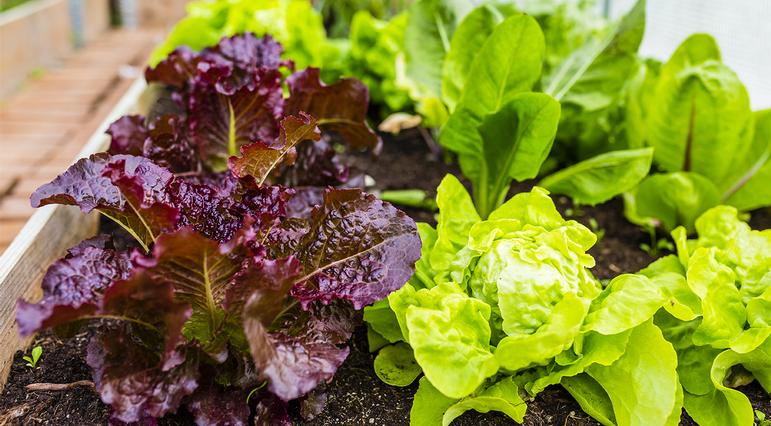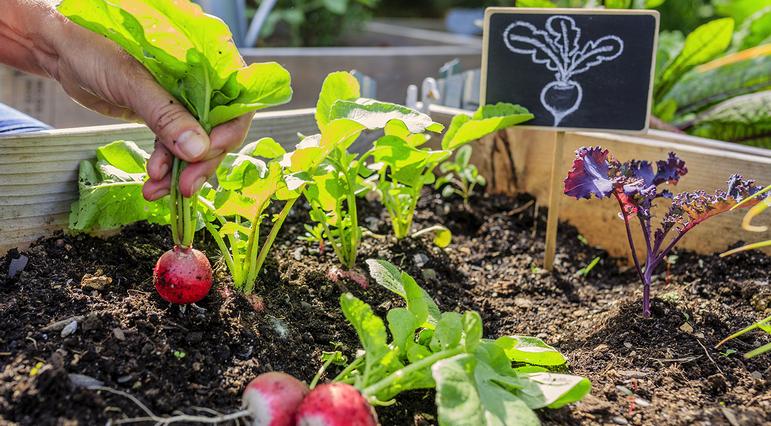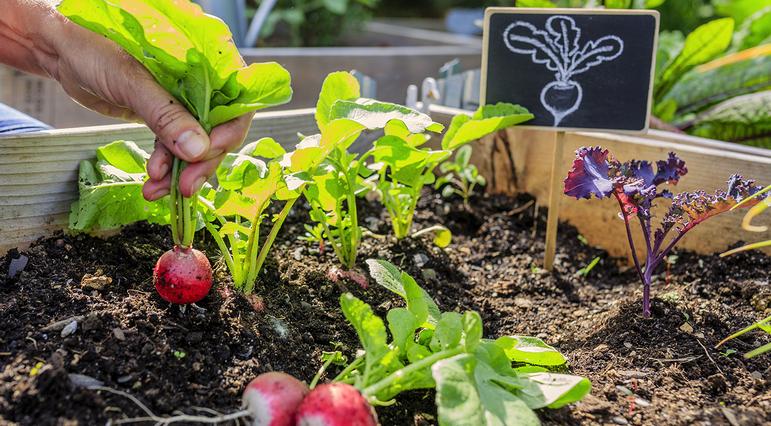Growing a Kitchen Garden

Why wait for spring to start growing fresh flavor? Start a kitchen garden and begin harvesting that home-grown taste within weeks!
Edible gardening is back in fashion, and we can’t wait to start growing our favorites this year in the garden. Luckily, there’s no need to wait to start enjoying the fresh flavors of summer. Kitchen gardens are small edible gardens that can be kept indoors or outdoors. Growing a kitchen garden means you’ll be able to control the entire production process of your food, letting you enjoy fresh produce grown without harsh chemicals. All you need is seeds, soil, and a sunny window to start infusing that home-grown taste into your recipes.
Kitchen Gardening for Beginners
If you’re new to growing plants from seed, we suggest starting with an indoor herb garden. Herbs are forgiving—they grow fast, need very little special maintenance, and they’re ready to eat in a matter of weeks. If you’re not the patient type, you can buy mature plants to care for and pinch off the leaves as you need them. However, if you don’t mind a project, you can start growing herbs from seed on your windowsill. Choose a south-facing window, which will give your plants the best sun exposure. Sow your seeds according to the directions on the packet, and water the soil to settle them in. For the first few weeks, it’s important to keep the soil evenly damp at all times—but not wet! The right moisture level should remind you of a damp sponge that’s been wrung out.
Herbs that work well for windowsill kitchen gardens in Delaware include:
-
Cilantro
-
Dill
-
Oregano
-
Basil
-
Chives
-
Mint
-
Parsley
-
Sage
You can also grow rosemary and thyme in your kitchen garden, but you may find it easier to buy a starter plant as they tend to grow rather slowly.
Within a few weeks, you should be able to start adding fresh herbs to your food! When using your herbs, never remove more than ⅓ of the leaves at once, or your plant may have trouble growing back. However, the more often you use your herb plants, the bigger and bushier they’ll grow!
Veggies for Kitchen Gardens

If you’re ready to move on to a bigger kitchen gardening project—albeit one that may outgrow your windowsill—you may find it useful to buy a simple grow lamp. Grow lamps are great for supplementing the limited sunlight we get through the winter here in New Castle County. With the help of a grow lamp and some organic fertilizer, you can also grow several versatile vegetables indoors. Here are a few to try, and how to grow them.
Radishes - Radishes pack a lot of peppery flavor into a small package, and they take very little time to grow. Sow radishes in soil enriched with plenty of compost, and space them 3-4 inches apart in a container that’s wider than it is deep. Place them in a spot that receives at least 6 hours of sunlight per day, supplementing with a grow lamp as needed. The sprouts, which are also edible, can be snipped off and eaten within as little as two weeks. Harvest the bulbs in as little as 1 month!
Salad Greens - You might be surprised by how easy it is to grow your own salad greens indoors! Lettuce, arugula, spinach, and mesclun grow quickly and can be grown indoors without a lot of effort. Plant them in a shallow container—a multi-cell plastic container for seed starting works very well. If you DIY your salad garden, choose a soil mix that’s suitable for seed starting, as the delicate greens won’t grow as well in standard potting or garden soil. It’s essential that the soil stays evenly moist, so after sowing and watering your seeds, cover the container loosely with plastic wrap to keep the moisture in. Greens do best with 12 hours of light per day, so you may need to supplement natural sunlight with a grow lamp. Your first harvest should be ready within a month!
Kitchen Gardening for Spring and Summer
You can also use your kitchen garden to get a head start on your warm-season crops. For an earlier harvest in the spring and summer, start these edibles indoors:
-
Potatoes - Start 4-6 weeks before last frost.
-
Tomatoes - Start 6 weeks before last frost, transplant when nighttime temperatures don’t dip below 50 ̊F.
-
Peppers - Start 4 weeks before daytime temperatures average 60-65 ̊F.
-
Onions - Start 9-10 weeks before last frost.
Looking for more inspiration for growing your own food? Visit our garden center in Hockessin to chat with our experts. We specialize in helping you find simple solutions for living, and growing, naturally.
